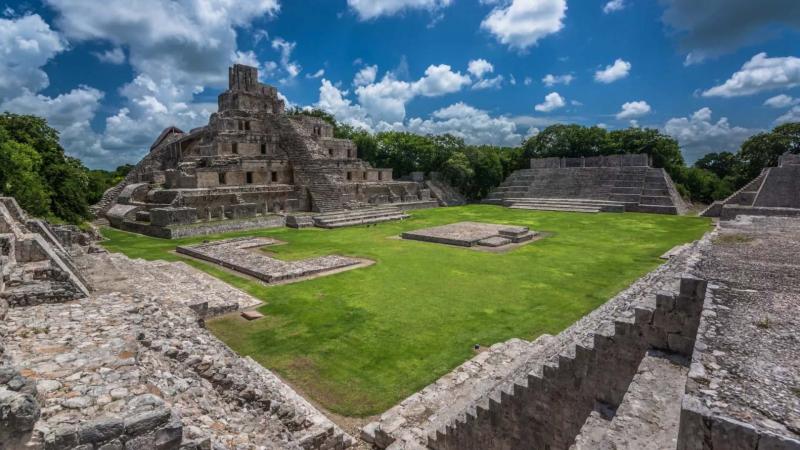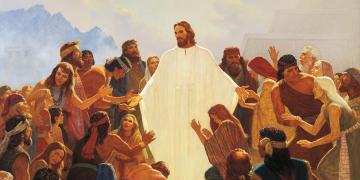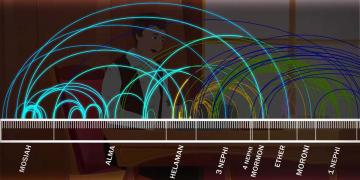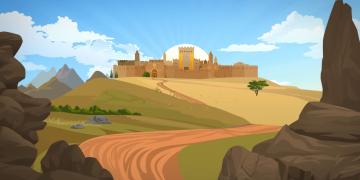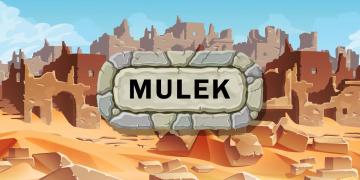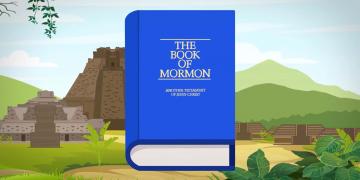You are here
5 Additional Compelling Archeological Evidences of the Book of Mormon
Because my first blog entitled “5 Compelling Archeological Evidences . . .” received a lot of fanfare, we felt it might be fun to present another five compelling physical evidences of the Book of Mormon. For now . . . just 5. A complete list of hundreds of evidences that have been identified can be examined at www.evidencecentral.org. For the purposes of this blog, I wanted to highlight evidences that strike me as particularly compelling. These evidences are well-vetted—not just willy-nilly corollaries—and should meet the following criteria: 1. specific rather than general, 2. rare or unusual, 3. historically aligned 4. and those that further illuminate or shed light on the meaning of the text.
More on these four criteria as this list is unfurled.
1. Sunken Cities
Sound like something out of Jules Verne? You betcha! Sunken cities are very specific and unique (criterion no. 1) and the Book of Mormon specifically describes how certain cities “and the inhabitants thereof” are destroyed by inundation. Three named communities—Jerusalem, Onihah, and Mocum—suffered this watery fate because, as the Lord explains, “. . . to hide their wickedness and abominations from before my face, that the blood of the prophets and the saints shall not come up any more unto me against them . . .” (3 Nephi 9:7).
Sunken cities are rare (criterion no. 2). Moreover, 3rd Nephi suggests these cities were submerged intact. The only natural phenomenon that explains the immersion of an intact metropolis are earthquakes and/or volcanic eruptions. These are not always expressions of the Lord’s wrath, but in this instance, they are.
Modern archeology has identified hundreds of sunken ruins, but relatively few in the western hemisphere. There are reports of submerged structures off the southwest coast of Cuba1 and other subaqueous ruins at different locations around Lake Titikaka2 in South America. Regarding Cuba, no serious researcher has yet proposed a Book of Mormon geography correlation. As for South America, such ties have been proposed, but the sunken ruins at Lake Titikaka are reportedly five-to-ten thousand years old.3 Thus, they would fail to satisfy criterion 3: historical alignment.
Some don’t understand—or don’t trust—modern dating techniques such as radiocarbon, potassium argon, or dendrochronology.4 However, until the Lord “reveals” such information through His designated Prophet, what else is there? Sans revelation, apply science. Any geographic proposals that dismiss such disciplines are likely to be flawed.
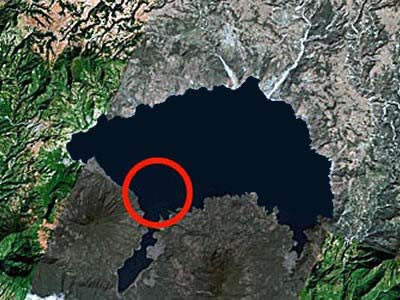
Circle indicates location of sunken ruins of Samabaj at Lake Atitlan, Guatemala
Enter Mesoamerica. In the mid-90s a recreational scuba diver named Roberto Samayoa noticed submerged buildings under the surface of Guatemala’s Lake Atitlan. His find eventually attracted the attention of accredited archaeologists. They began to seriously study the area, utilizing sonar scanning to pinpoint additional underwater edifices.5
Dr. John Sorenson noted that the “buildings appear to have been undamaged before their submersion, implying a sudden rise of the water.”6 Researchers reportedly found “about 30 ancient homes, a plaza, staircases, and even saunas, among the submerged ruins . . .” as well as 16 religious structures and at least seven stela. Sonya Medrano, an archaeologist involved in the site’s underwater excavation and mapping, described it as “a place of public rituals and pilgrimage.” The sudden rise in water that submerged these 30 acres of ruins has been attributed to likely volcanic activity.7 Medrano dated “the island’s moment of destruction to no later than A.D. 300.”8 After examining ceramic remains, Sorenson dated the site to the “Late Pre-Classic period, probably around the time of Christ.”9
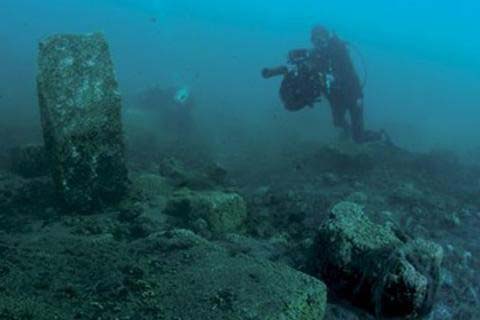
Diver explores submerged ruins of Samabaj.
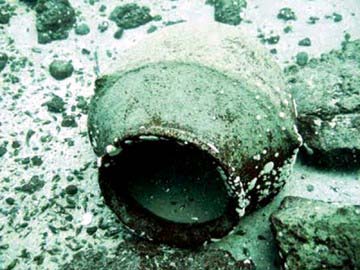
Underwater pottery at Samabaj, Lake Atitlan, Guatemala.
Prior to the discovery of these ruins, Latter-day Saint scholars had already designated Lake Atitlan as a strong candidate for the location of Jerusalem, one of the cities mentioned in 3rd Nephi. Roberto Samayoa’s diving exploits only seemed to reinforce this proposal.
Artifacts from this submerged city are presently on display in small museum in Panajachel, Guatemala.
Rare event, right place, right time period. What are the odds?
For further reading:
Book of Mormon Central, “Is There Evidence of Sunken Cities in Ancient America? (3 Nephi 9:7),” KnoWhy 429 (May 1, 2018).
Book of Mormon Central, “Book of Mormon Evidence: Sunken Cities,” Evidence Central, (February 2, 2021)
2. Beards
Huh? Whiskers as a witness?
Indeed. After all, how many bearded Blackfoot do you see? Or shaggy Shoshoni? Or hirsute Hopi? Or wooly Walla Walla? Native Americans don’t seem to grow a lot of facial hair. It’s a genetic thing. There are notable exceptions. The Haida of the Pacific Northwest, Pomo of northern California, and certain tribes in southern Chile can grow impressive manes. Still, indigenous peoples of the Western Hemisphere don’t typically sport five o’clock shadows.
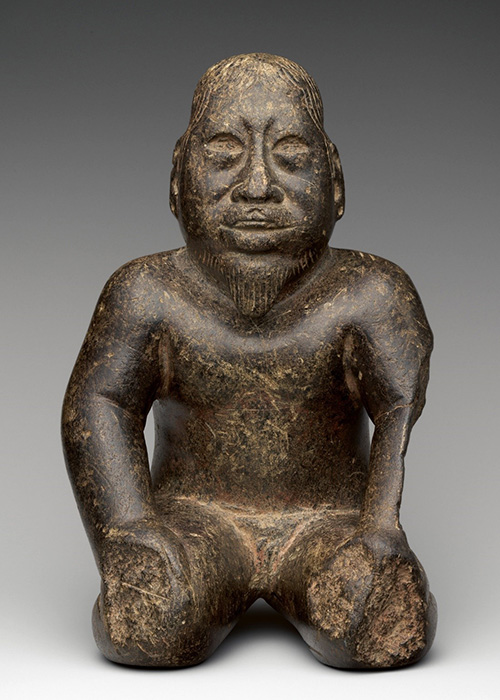
Olmec Bearded Figurine, The Metropolitan Museum of Art
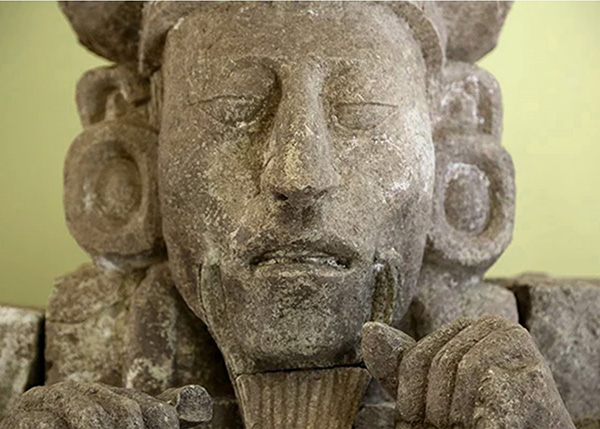
Sculptured head of a bearded Maya king from Copan, Honduras.
So how do we explain all the hundreds, even thousands, of ancient artifacts that feature figures with facial hair? Many are aware of the “white-bearded-God-who-would-one-day-return” folklore that permeates Mesoamerican culture. The Spanish chroniclers knew this mythology had played an undeniable role in Moctezuma’s downfall. In the mid-1500s friar Bernardo Sahagun wrote that the legendary figure known as Quetzalcoatl “was esteemed and considered as a god, and was worshipped in older times. He had long hair and was bearded. The people worshipped only the Lord . . .”10 This same bearded characteristic was ascribed to other New World deities.11
Upon hearing about the bearded Cortez, the emperor became so stricken with fear and indecision that his millions-strong Aztec empire was swept, by an army of about five hundred European soldiers and a few thousand disgruntled native mercenaries, into the dustbin of history.
Latter-day researchers were several centuries late to the game of pondering a correlation between Christianity and Mesoamerica.
Examining the various bearded figures etched on stela or painted on pottery, it’s clear that many images aren’t deities, but mortal, flesh-and-blood, men. So what became of hereditary facial hair by the time of Columbus? Prior to the Spanish conquest, tribal leaders had taken to donning fake or fabricated whiskers, as if keeping alive some prevailing sentiment from the past when bearded individuals had symbolized dominance, authority, and even godliness. Another interesting pursuit for modern researchers suddenly becomes analyzing the hemispheric distribution of bearded iconography as it correlates with archeological periods, i.e., Pre-Classic (AD 250 and earlier), Classic (AD 250-900), and Post Classic (AD 900-1521).
It seems safe to presume any Middle-Eastern migration, as recorded in the Book of Mormon, would have introduced facial hair to the local gene pool (see 2 Ne. 17:20). For about a century after the Book of Mormon was published many naturally assumed Lehi arrived to find an empty, uninhabited land. That idea has long been abandoned by most Latter-day Saint researchers. Both science and the Book of Mormon text itself indicate that Lehites, Jaredites, and “Mulekites” were never alone.
In a statistical analysis conducted by Kirk Magleby12, and another study by F. David Lee13 of hundreds of artistic representations of beards, certain fascinating patterns emerge. Bearded figures carved in stone or painted on murals are far more common in central and southern Mesoamerica, with the isthmus of Tehuantepec serving as the distributary nexus. LDS archeologist V. Garth Norman observed, “Although bearded figures date from all time periods, Magleby found that they were more frequent during Book of Mormon times before A.D. 300, and became relatively rare by Spanish contact times.” Additionally, “The decline of Mormon's people in war and survivors being assimilated into the dominant Mesoamerican "Lamanite" population, must have depleted the beard gene pool by the time the Spaniards arrived in the 16th century.”14
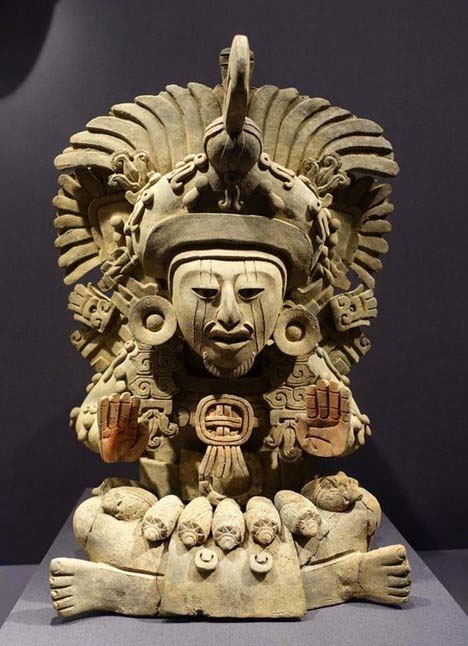
Zapotec funerary urn found in Oazaca, Mexico, 350-500 AD.
Another analysis by non-Latter-day Saint researcher Alexander von Wuthenau states, "I began an intensified study of pre-Columbian terracotta heads. What I was looking for were typical 'Indian' heads. It was not long, however, before I discovered that in the early, lower levels these 'genuine Indians' were not to be found. The earliest figures encountered were those with Mongoloid characteristics, and all kinds of white people, especially Semitic types with and without beards. What is considered to be genuine Indian only developed, so far as I am able to judge on the strength of these terracotta representations, in early and middle Classic times, and probably derived from earlier types."15
Additional sources further emphasize the dating, frequency, and distribution of bearded artifacts that closely parallel Book of Mormon migration accounts. This data helps not only verify when these interlopers might’ve arrived, but when their civilizations climaxed and declined. The rampant Nephite “genocide” that transpired in the 3rd and 4th centuries AD, alongside the assimilation of Nephite survivors into the dominant population, served to diminish or erase genetic tags like facial hair. Science calls this a “genetic bottleneck.” This gene dilution also helps explain why Mormon in 3 Nephi 5:20 felt compelled to proclaim himself a “pure Nephite”—as opposed to many others in his army who were not. Parallels with the archeological record are uncanny, making the 3rd criterion—historical alignment—fit like a proverbial glove. This criterion is further underlined by the dating, frequency, and distribution of bearded art and iconography, which simultaneously serves to emphasize Mesoamerica as a more likely candidate for Book of Mormon events.
But don’t stop now! Further enlightenment beckons at these links:
Book of Mormon Central, “Book of Mormon Evidence: Beards,” Evidence Central (June 28, 2021).
Ottinger, G.M.. "Old America - Araucanians, Brazilians, Etc." Juvenile Instructor 11, no. 10 (1876): 111-112.
3. Fortifications
Carbon 14 dating.
Oh, I’m perfectly aware of a vocal contingent that vociferously distrusts this technique, feeling its findings are too often at odds with their limited views on the age of things. This attitude is foolish. I suppose skepticism may be warranted in the case of a single test in a single location prompting a singular interpretation. What about hundreds of tests corroborating the same data? That’s precisely what we find when addressing Book of Mormon evidence and military fortifications.
Sometimes powerful evidences aren’t as straightforward as pointing a finger at the alters of Nahom. Gotta focus. Gotta invest a modicum of effort. Start by going to: https://bookofmormonresources.blogspot.com/2017/02/75-bc.html. Actually, go here often. I’ve heard folks say, “Where in blazes do I find new scholarly stuff on the Book of Mormon?” Well . . . now you know.
So let’s dig into this. (Pun! Didn’t notice till I wrote it.) Middle America has no dearth of ancient cities encircled by fortifications. Here’s a better question: Where are these fortified sites concentrated? Or better yet: When was the construction of such fortifications first initiated? That’s where there’s gold in dem dar carbon-14 tests.
To better illustrate this evidence let’s review some of the early scientific perspectives on the ancient ruins of the western hemisphere. The original consensus was that colossal sites like Teotihuacan, Palenque, and Copán couldn’t possibly be cities. These were strictly ceremonial centers—pilgrimage sites for religious rituals. If these places were actual communities sustaining large populations why were they so utterly abandoned?
It wasn’t until the mid-20th century that archeologists finally conceded that, yeah, it wouldn’t have made much sense to build these massive structures in the middle of nowhere, unless it also supported a permanent population. Then how come such places were left to rot in the overgrowth? It’d be several more decades before science finally caught up with the panoramic tableau of the Book of Mormon. Fact: the impenetrable jungles of the Petén and other regions of Mesoamerica once supported bustling cities with millions of inhabitants. Yet another paradigm shift is the view that the ancient Maya were peace-loving ecologists. Today we acknowledge that bloody warfare was endemic, particularly during the early classic from 250-500 AD (see Mormon 8:8 and Moroni 1:2).
For a half century Latter-day Saint scientists and researchers relied on archeological analyses of sites like Becán (and to a lesser extent Tikal) as the best example of the kind of military fortifications conceived and constructed by Captain Moroni. This was a fine start, but the Book of Mormon names city after city in the land of Zarahemla—and beyond—that underwent defensive renovations in the first century BC to fortify against armies of the Lamanites and Gadiantons. The Book of Mormon is rather specific about when Moroni and his military successors—Moronihah and Gidgiddoni—struck these fortifications. Based upon a limited geographic interpretation of the text, we ought to find a heavy concentration of communities surrounded by ditches and earthen ramparts, including evidence of stone and/or timber walls and palisades, watchtowers, places of resort, and even roads and causeways for the ease of troop deployment (the scriptures are replete with these details. See Alma 48:5-8, 49:12-15, 18, 22, 50:1, 4, 6, 12, 52:6, 53:3). Moreover, many defense works ought to date to the period known as the “terminal pre-classic” (ca. 100 BC to 100 AD), thus encompassing fortifications initiated by Moroni and his successors.
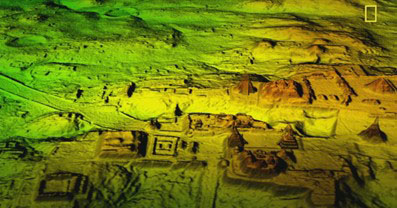
Lidar image of massive ruins discovered in the jungles of Guatemala
Now comes the fun part. Let’s laser-focus on the new and exciting technology called LiDAR. LiDAR is an acronym stemming from “coherent light detecting and ranging." Simply put, expensive equipment is flown in a slow grid pattern over a geographic area wherein billions of laser pulses create 3-dimensional images of structures hidden beneath the dense jungle canopy. In 2018 the largest survey ever attempted for archeological research took place in southern Guatemala, mapping 2100 square kilometers near the Mirador Basin, or an area about half the size of Utah County.
What they found is jaw-dropping, especially as it relates to the Book of Mormon. At least 31 instances of defended areas were identified amidst a vast network of heretofore unknown settlements and villages. This fortification density was entirely unexpected by the archeologists who first reviewed the data. Some sites whose fortifications date to the terminal pre-classic period include El Mirador, Becan, Edzna, Cerros, Muralla de Leon, Civil, Chaak Ak’al, and multiple hilltop ruins along the upper Usumacinta River such as Piedras Negras.
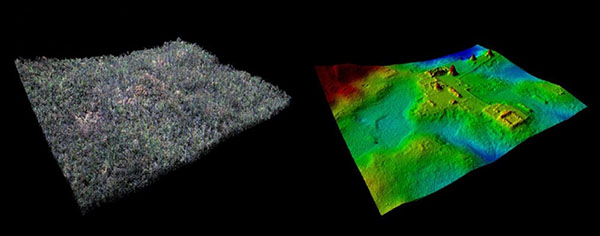
Lidar has revealed more than 60,000 undiscovered structures under the jungle canopies of Guatemala.
Population estimates of the Maya region at its apogee have been revised upward to 20 million. This is half the population of Europe during the same period, even though the Maya occupied about one-30th of the land mass, thus correlating with the "numberless hosts" mentioned in verses like Alma 51:27.
It’s too early to draw concrete conclusions about precisely how these areas fit into the Book of Mormon milieu. It’ll take decades to complete ground surveys of thousands of manmade structures exposed by LiDAR, but the “big picture” revealed thus far fits remarkably with the war-torn world of Captain Moroni outlined in the Book of Mormon.
For more information check out these online articles and blogs:
https://evidencecentral.org/recency/evidence/fortifications
https://bookofmormonresources.blogspot.com/2018/02/lidar.html
https://bookofmormonresources.blogspot.com/2018/10/ground-truthed-lidar.html
https://bookofmormonresources.blogspot.com/2019/03/light-from-guatemala.html
https://bookofmormonresources.blogspot.com/2019/08/captain-moronis-towers.html
4. Olmec Iron
Sometimes the Book of Mormon rings glorious not just for what it says, but for what it doesn’t say. Check out this verse from Ether:
And they did work in all manner of ore, and they did make gold, and silver, and iron, and brass, and all manner of metals; and they did dig it out of the earth; wherefore, they did cast up mighty heaps of earth to get ore, of gold, and of silver, and of iron, and of copper. And they did work all manner of fine work (Ether 10:24).
Did you catch it? I mean, did you catch what the Book of Mormon did not say? This is a rather detailed verse discussing Jaredite metalwork. The conspicuously missing term is smelting, i.e., the concept of melting down raw ore—iron in particular—and fashioning tools, weapons, ornaments, and other novelties from its molten state.
The authors and compilers of the Book of Mormon certainly understood the concept of smelting ore. Nephi built a bellows to make iron tools to complete his ship to the promised land (1 Ne. 17:9,17). Moroni mourned that he’d run out of room to write on his father’s plates and lacked ore to create more (Mormon 8:5), although in coming years he did find such ore and managed to formulate enough additional plates to complete his own record, as well as an abridgement of the record of Ether. Jared and his descendants were also familiar with the smelting process. In the days of Shule they melted down ore from the hill Ephraim to forge steel swords, which weapons proved critical in securing Shule’s decisive victory in battle, suggesting that such weapons among the Jaredites were rare (Ether 7:9).
The archeological data confirms that metalwork in pre-classic times, especially in the period corresponding to Ether 10:24, accurately matches the process described in the verse. The key phrases are “they did dig [ore] out of the earth” and “they did cast up mighty heaps of earth to get ore”. Before I’d read about this topic, I wasn’t aware that useful objects could be fashioned from naturally-occurring hunks of hematite, magnetite, and ilmenite harvested straight out of the earth. Such iron globs were then sculpted and polished much like marble or granite, except the crafting process is more precise and intensive.16
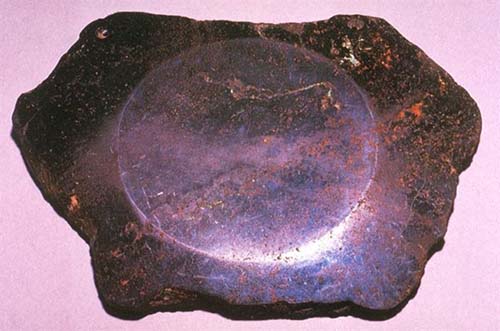
Olmec iron ore mirror from Gurerrero, Mexico. Photo by Linda Schele.
Lo and behold, shops that engaged in this type of metalwork thrived during the pre-classic period of the Olmecs. The Olmeca civilization—so named by later civilizations (roughly translated as “people of the rubber tree”)—is often correlated to the Jaredites. Dates corresponding to the rise and fall of the Jaredites compared to the rise and fall of the Olmecs have so many parallels that it’s oft proposed that they are, generally speaking, one and the same. Such an “iron-clad” conclusion may be oversimplified and requires further marinating and research. Nevertheless, shops that fashioned artifacts from blocks of ilmenite ore have been identified at three sites in the Olmec heartland: San Lorenzo in Veracruz, and Mirador Plumajillo and Amatal, both in Chiapas. The ore was imported from igneous sources in Oaxaca and Chiapas.
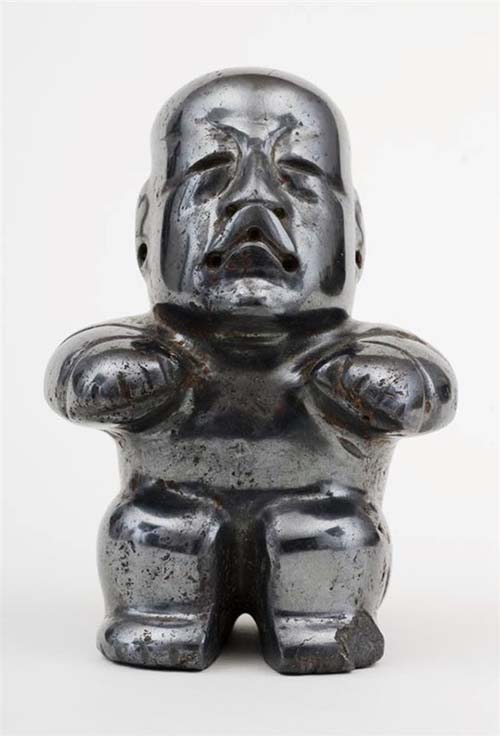
Olmec figurine formed from solid piece of iron ore.
Researcher Ann Cyphers Guillén discovered 8 tons of polished, perforated iron-ore beads at a workshop near the first Olmec capital of San Lorenzo, dating to ca. 1100 BC, or the same general period as Ether 10:24.17
For further reading:
Steven E. Jones, Samuel T. Jones, and David E. Jones, “Archaeometry Applied to Olmec Iron-ore Beads,” BYU Studies Quarterly 37, no. 4 (1997): 129–142.
John L. Sorenson, Mormon’s Codex: An Ancient American Book (Provo and Salt Lake City, UT: Neal A. Maxwell Institute for Religious Scholarship and Deseret Book, 2013), 331–344.
Jerry D. Grover, Jr., “The Swords of Shule,” in The Swords of Shule: Jaredite Land Northward Chronology, Geography, and Culture in Mesoamerica (Provo, UT: Challex Scientific Publishing, 2018), 267–281.
Book of Mormon Central, “Book of Mormon Evidence: Olmec Iron,” Evidence Central (September 19, 2020)
5. “Outgrowth” of the Heart
Another phrase used to describe this particular Book of Mormon evidence is “anthropomorphic trees.” It’s an abstract idea and may not click right away in our western minds, but when placed in its proper cultural context this recurrent ancient American image is beautiful and profound. Its correlation with the parable in Alma 32 of a seed sprouting into a fruit-bearing “tree of life” by nourishing one’s faith in God’s word becomes self-evident.
Below is a very clean reproduction of two “sacred ancestors” carved on the sarcophagus of Pakal at Palenque. Such figures were revered by the ancient peoples as symbolic entities of wisdom and goodness. In this carving they are depicted as anthropomorphic fruit trees or as beings with fruit-bearing plants sprouting from their bodies.
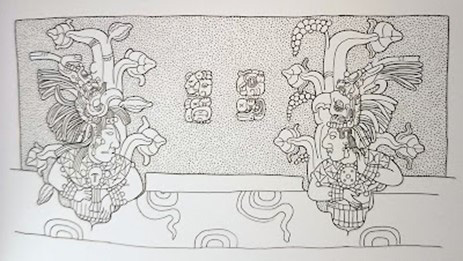
Figure 1
In Alma 32 we read:
Now, we will compare the word unto a seed. Now, if ye give place, that a seed may be planted in your heart, behold, if it be a true seed, or a good seed, if ye do not cast it out by your unbelief, that ye will resist the Spirit of the Lord, behold, it will begin to swell within your breasts; and when you feel these swelling motions, ye will begin to say within yourselves—It must needs be that this is a good seed, or that the word is good, for it beginneth to enlarge my soul; yea, it beginneth to enlighten my understanding, yea, it beginneth to be delicious to me (vs 28).
But if ye will nourish the word, yea, nourish the tree as it beginneth to grow, by your faith with great diligence, and with patience, looking forward to the fruit thereof, it shall take root; and behold it shall be a tree springing up unto everlasting life (vs 41).
Few would deny the far-reaching impact that these verses have had upon the minds and hearts of today’s Latter-day Saints. We should not, therefore, underestimate the depth of impact they’d have had upon the minds and hearts of those who heard this metaphor from the mouth of the Prophet Alma. The concept of fruitful plants sprouting from the physical bodies of deities and esteemed leaders existed prior to Alma’s sermon, as far back as Olmec times at sites like Izapa in southern Mexico. It’s easy to imagine an inspired Alma the Younger utilizing this extant symbolism to impress upon the minds of the humble, impoverished citizens of the Zoramites that they need not rely upon intermediaries among the elite to exercise faith, as had been the prevailing tradition. They, themselves, could pray directly to God to importune His blessings. The components of this metaphor are very specific (criterion no. 1) and celebrated in no other global culture (criterion no. 2).
Below is a variation of this iconic theme from the post-classic Codex Fejervary-Mayer thought to have originated in Veracruz. The image depicts the Aztec sun god, Tlaloc, tending to a human maize plant.
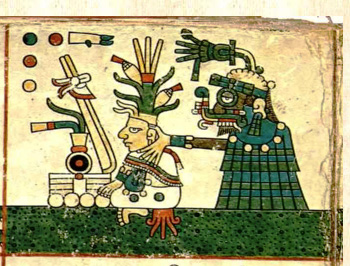
Figure 2
In this next drawing the figure on the right is a monkey scribe holding a codex. The figure on the left has his hand on the scribe’s back. A corn stalk is sprouting out from beneath his right arm.18
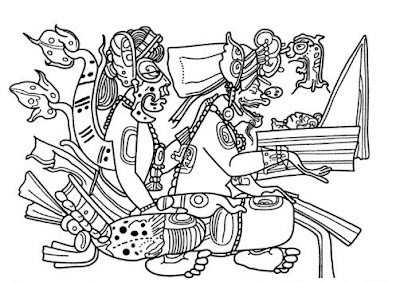
Figure 3
The basic metaphor of favor, fertility, and salvation blossoming from the human heart continued well beyond the destruction of the Nephites, and is depicted in the following images as bountiful trees sprouting from the chests of sacrificial victims.
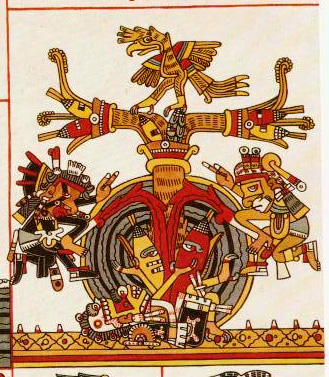
Figure 419
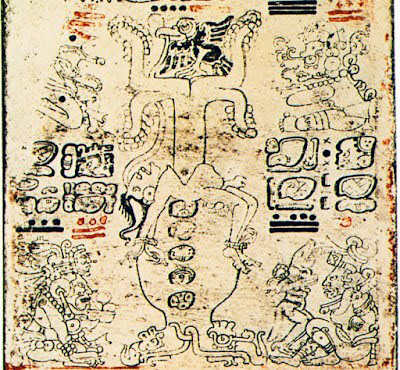
Figure 520
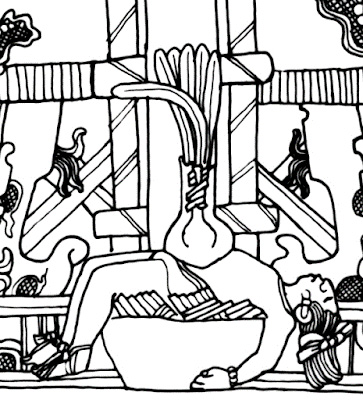
Figure 621
The central theme of a seed planted in the heart and nourished until is swells into a fruit-bearing “tree of eternal life” retained its unique and extraordinary character for generations throughout Mesoamerica, thus illuminating the power and meaning of Alma’s spiritual exhortation to the Zoramites (criterion no. 4). It therefore qualifies as yet another compelling evidence of the Book of Mormon’s relevance and historicity.
To learn more visit:
https://bookofmormonresources.blogspot.com/2016/02/anthropomorphic-trees.html
Clark, John E., “Archeology, Relics, and Book of Mormon Belief,” Journal of Book of Mormon Studies, Vol. 14, No. 2 (2005): 38–49, 71–74.
Book of Mormon Central, “Book of Mormon Evidence: Tree Planted in Heart,” Evidence Central (September 19, 2020).
Conclusion
So many resources. So much supporting data. It all seems so obvious to me. But perhaps that’s because of the time and effort I’ve invested delving into the historical literature and scientific publications. In light of that, I should confess that my original testimony is based on none of it. I received my testimony of the Book of Mormon when I very young—a mere lad of 18 years. At the time I knew diddly-squat about the ancient civilizations of the New World. I simply read the volume and put the promise in Moroni 10:3-5 to the test, much like millions of others have done since the volume was published. It was the spiritual confirmation I received on a November eve in 1981 that eventually compelled me to embark on a personal odyssey to learn as much as I could about the people and places described in its pages. Such studies have enhanced my testimony, but they certainly aren’t the source of it.
In the near future I hope we’ll tackle another five compelling evidences of the Book of Mormon. Until then I hope everyone will continue to immerse themselves in its pages and reap every blessing and benefit that this sacred volume has to offer—the depth and breadth of which I don’t think have ever been “scientifically” determined.
- 1. Holloway, April, “What Happened to the Sunken City of Cuba?”, July 22 2014, Ancient Origins.
- 2. Truman, Dave, “The Sunken Cities of Titikaka: Just Gilded Fables, or the Relics of an Ancient History that is Being Suppressed?”, Mar 3, 2017.
- 3. Ibid. The ages of Titikaka’s submerged ruins are cited numerous times by Bolivian, Brazilian, Italian, and French archeologists in Truman’s article, none later than 2000 B.C.
- 4. Dendrochronology is the study of the environmental effects on the width of tree rings through time. Radiocarbon dating of tree ring records allows scientists to construct a reliable record of the concentration of carbon-14 in the atmosphere. This composite record allows eruptions to be dated by matching the wiggly trace of carbon-14 in a tree killed by an eruption to the wiggly trace of atmospheric carbon-14 from the reference curve (“wiggle-match” dating). Scientific dating techniques have greatly improved in recent decades, but the author cannot confirm if the most advanced techniques were applied by archeologists at sunken ruins around Lake Titikaka. For more information generally on current scientific dating methods, especially associated with volcanic eruptions, see https://www.sciencelearn.org.nz/resources/2698-explosive-lies-how-volcanoes-can-lie-about-their-age-and-what-it-means-for-us. Also, see associated links provided on this page.
- 5. Based upon an unpublished geophysical survey examined by Book of Mormon Central staff.
- 6. Atwood, “Lost Island of the Maya,” 43.
- 7. Based on an unpublished geophysical survey. See also, Atwood, “Lost Island of the Maya,” 42. For information about the natural disasters in 3 Nephi and their likely connection to volcanic and geological activity, see Book of Mormon Central, “What Caused the Darkness and Destruction in the 34th Year? (3 Nephi 8:20),” KnoWhy 197 (September 28, 2016).
- 8. Atwood, “Lost Island of the Maya,” 43.
- 9. Sorenson, Mormon’s Codex, 647. According to Sorenson, his proposed Book of Mormon geography “plausibly places the city of Jerusalem on the south shore of the Lake Atitlan. The near agreement in time between the flooding described in the Book of Mormon city and the rise of the lake waters over Samabaj, as well as the seemingly abrupt manner of that rise, is striking.” Although the timing of the site’s flooding may be too late, Sorenson’s geographical correlation is still intriguing and deserves further consideration and exploration.
- 10. Sahagun, Bernardo de, Historia General de las Cosas de Nueva España,” Mexico: Editorial Porrua, S. A., 1985, pp. 195, 598).
- 11. Historia de las Indias de Nueva España, 1867, first ed., 2 vols., Mexico: Editorial Porrua, S. A., 1967, 1:9.
- 12. Kirk Magleby, “A Survey of Mesoamerican Bearded Figures” (F.A.R.M.S. paper, 1979).
- 13. http://www.bmaf.org/conference/2008/david_lee
- 14. Norman, V. Garth, “Bearded Foreigners in Mesoamerica,” Feb. 2005.
- 15. Alexander von Wuthenau, The Art of Terracotta Pottery in Pre-Columbian Central and South America, (New York, Crown publishers, Inc. 1969).
- 16. Carlson, John B., “Olmec Concave Iron-Ore Mirrors: The Aesthetics of a Lithic Technology and the Lord of the Mirror” in The Olmec and Their Neighbors: Essays in Memory of Matthew W. Stirling, ed. Matthew W. Stirling, Michael D. Coe, Elizabeth P. Benson, and David C. Grove (Washington, DC: Dumbarton Oaks, 1981). Matthew Stirling discovered polished hematite mirrors at La Venta in the 1940s.
- 17. Guillén, Ann Cyphers, “San Lorenzo Tenochtitlán” in Los Olmecas en Mesoamérica, ed. John E. Clark (Mexico City: Citibank/Mexico, 1994), 43–67.
- 18. This is figure 6 from the article “Mathematics of the Maya” by Michael P. Closs in Encyclopaedia of the History of Science, Technology, and Medicine in Non-Western Cultures, edited by Helain Selin, (New York: Springer-Science=business Media, B.V., 1997), p. 650.
- 19. This image of a tree growing out of a skeletal figure is from the post-classic Codex Borgia thought to have originated in Puebla.
- 20. This example is from page 3 of the Dresden Codex which dates to ca. AD 1100 and comes from Chichen Itza, Yucatan. It depicts the “tree of life” growing out of the sacrificed body of the maize god.
- 21. This image from Piedras Negras Stela 11 depicts a seedling sprouting from the heart of a sacrificial victim. Drawing by Linda Schele.
Subscribe
Get the latest updates on Book of Mormon topics and research for free


